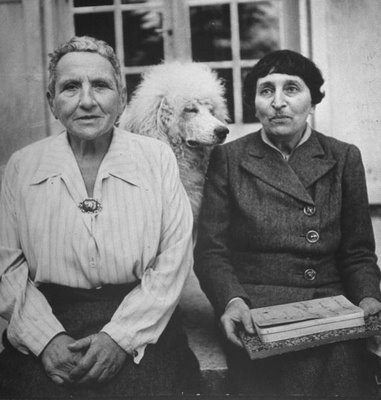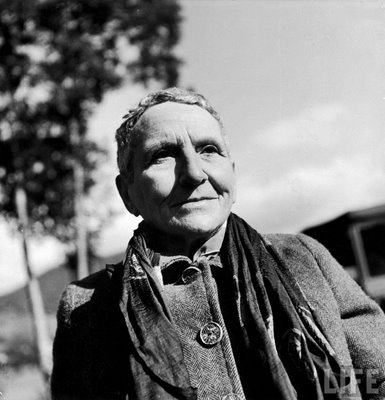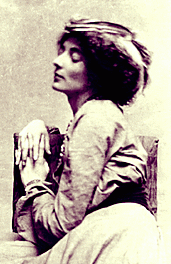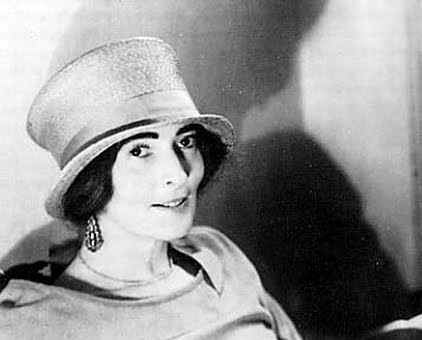Lesbian and Bisexual Women of History Who Were Obsessed With Their Dogs, Part 2
Last time on Lesbian and Bisexual Women Who Were Obsessed with Their Dogs, we learned many lessons from our queer ancestors about how best to incorporate your canine companions in to your lifestyle. There was a big yes to fashion photoshoots, European travel and fleeing the patriarchy; a big no to stage plays, and a big WTF to worshipping your dog as the reincarnation of Christ. Also if you haven’t written your dog’s-eye-view novel yet, you need to get on that right away.
I’m sure at least one reader has been panting with anticipation about what further revelations lurk in our woefully unexplored queer pupper past. Find out literally right now, as we continue our historical adventures with gal’s best pal!
Emily Dickinson
Emily Dickinson, America’s favourite depressive poet, came from a wealthy, well-educated family in 19th century Amherst, Massachusetts. Despite her strong intellect and probably because of the mental illnesses that would bring her great suffering throughout her life, Emily only made it partway through her schooling at Mount Holyoke Female Seminary and returned home to teenage years of increasing isolation.
Perhaps observant of her lack of companionship, Emily’s dad Edward gave her a brown Newfoundland puppy in 1849. Emily named him Carlo, after a dog in Jane Eyre, and he quickly grew to about three times the size of the diminutive young poet, a sight that amused visitors. Dickinson’s first ever published work in the Amherst College paper in 1850 also contains her first written reference to Carlo, as part of a lengthy and accomplished metaphor from which I have conveniently extracted just the dog parts:
“If it was my Carlo now! The Dog is the noblest work of Art, sir. I may safely say the noblest — his mistress’s rights he doth defend — although it bring him to his end — although to death it doth him send!”
Sadly, no pictures of Carlo exist, but here is an artist’s impression of a Newfoundland from 1858
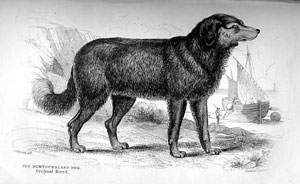
It was around this time that Emily forged another close bond, with Susan Gilbert, a student her own age who shared a lot of her interests, including despair about their lot in life as housewives-to-be and the dislike of household chores (although Emily was actually a champion baker). Susan’s erudition and passion for literature would inspire over 300 letters from Emily over the course of her life, far more than to any other correspondent, and included many of Emily’s most famous poems. Of course, scholars argue over whether the nature of their attachment progressed from friendship to romantic friendship, or even something more, but we can all use our rational gay judgement to reach the correct conclusion. Whatever their relationship, it didn’t stop Susan going on to marry Emily’s elder brother, Austen.
“Oh Susie, I often think that I will try to tell you how very dear you are, and how I’m watching for you, but the words wont come, tho’ the tears will, and I sit down disappointed — yet darling, you know it all — then why do I seek to tell you? I do not know; in thinking of those I love, my reason is all gone from me, and I do fear sometimes that I must make a hospital for the hopelessly insane, and chain me up there such times, so I wont injure you” – Emily Dickinson, defining “chill” in 1852
Her breast is fit for pearls,
But I was not a “Diver” –
Her brow is fit for thrones
But I have not a crest.
Her heart is fit for home
I – a Sparrow – build there
Sweet of twigs and twine
My perennial nest.
—Totally casual poem Emily wrote in a letter to Susan, 1859
In her late twenties, Emily famously began a long period of reclusion, but in truth she wasn’t completely alone, she was eschewing the company of humans for wild nights in with Carlo. Although Susan was the audience for much of her literary output, the only creature that she shared all her work with was her beloved Carlo, whose patient nature could withstand her darkest of spells.
“Of ‘shunning Men and Women’ … He and I don’t object to them, if they’ll exist their side” – Emily Dickinson on her and Carlo’s understandable view of other people
“You ask of my companions. Hills, sir, and the sundown, and a dog as large as myself that my father bought me. They are better than human beings, because they know but do not tell.”
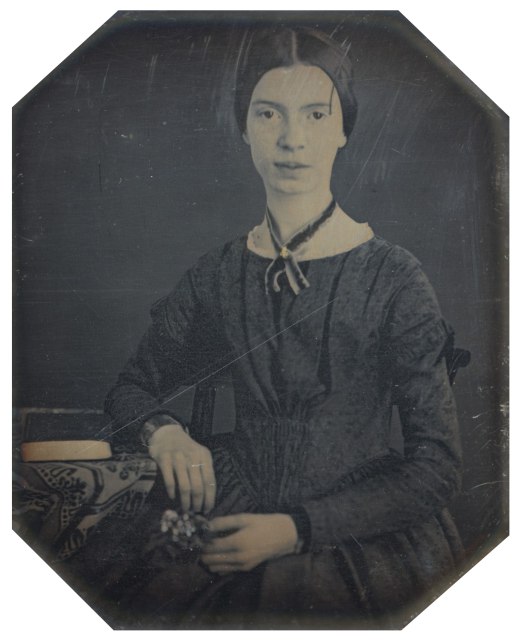
The only photo of Emily Dickinson ever.
Emily broke out of her depression for a period of prolific creativity in the early 1860s, producing almost 700 hundred poems between 1862-1864. During this intensity, Carlo was a steadfast companion, providing some balance for the manic Emily.
“I talk of all these things with Carlo, and his eyes grow meaning, and his shaggy feet keep a slower pace.”
Worsening health problems put the brakes on her literary output, and worst of all, Carlo died in 1866. Emily never got over the loss of her “Shaggy Ally,” and couldn’t bring herself to replace him. Without her protector and barrier to the outside world, her reclusiveness increased. She continued to write, but she never matched the volume of correspondence and poetry as those years with Carlo, and eventually succumbed to a long illness in 1886. At least she had this thought to comfort her: “I believe that the first to come and greet me when I go to heaven will be this dear, faithful, old friend Carlo?”
Virginia Woolf and Vita Sackville-West
The protagonists of one of history’s most compelling lesbian love affairs, Virginia Woolf and Vita Sackville-West were both accomplished writers: Virginia, now famed for her experimental novels, while Vita’s work encompassed poetry, travel writing and journalism as well as novels. But most importantly, they both wrote about dogs.
Virginia’s family, although middle-class and financially comfortable, was highly chaotic and led to a childhood punctuated with loss (her mother died when Virginia was 13) and sexual abuse (by her stepbrother Gerald). Dogs would act both as a stabiliser during these manic years, and a bridge between Virginia and her sister Vanessa, who was generally considered the “dog person” among the siblings. Among their childhood dogs were Shag, an overly-docile terrier picked up on holiday in Cornwall who failed miserably at his rat-catching duties, and Jerry who would make continual bids for freedom from their home in London’s Hyde Park.
As a teenager, Virginia developed a crush on one of her mother’s friends, Violet Dickinson, and got her first practice at one of her least-reported, yet most frequently-used literary devices: expressing your repressed sexual attraction for girls by conflating them with dog feelings. Here she is, in a totes platonic letter, imagining herself as Violet’s Chow, Robert:
“I think with Joy of certain exquisite moments when Rupert and I lick your forehead with a red-tongue and a purple tongue; and twine your hairs round our noses.”
One of Virginia’s strongest canine attachments was with her sister’s sheepdog Gurth, who she would walk around Regent’s Park, giving her comfort during her times of breakdown, as well as providing inspiration for works to come. Although she would occasionally grow weary with Gurth’s constant vigilance of her, she grew such a high regard for him that often the best compliment she could give a human was to compare them to a sheepdog.
To supplement Gurth’s visits, Virginia and her brother Adrian got another dog of their own, a boxer named Hans, who she taught the very important trick of putting out matches she’d use to light cigarettes (a trick she’d teach all her future dogs too).
In August 1910, Virginia married Leonard Woolf, a friend of her brother Thoby’s. Virginia and Leonard did not have sex, but very quickly they did have dogs: the first called Max, then a Climber Spaniel called Tinker, who they adopted from a friend for a month, most of which Virginia spent carefully observing him. As noted by her nephew and biographer Quentin Bell “Her affection was odd and remote. She wanted to know what her dog was feeling but then she wanted to know what everyone was feeling, and perhaps dogs were no more inscrutable than most humans.” In 1919, the couple acquired a new terrier, Grizzle, who became an integral part of their life in Sussex, going on long rambles through the countryside with Virginia, while she and Leonard set up their print business, Hogarth Press.
This idyllic lifestyle was rocked by a gay interruption in the 1920s, when Virginia began her decade-long affair with Vita Sackville-West. Vita, born in 1892 to an aristocratic family in Kent, was confident and well-travelled; almost the polar opposite of Virginia, whose mental illnesses often kept her both socially and geographically confined. In her estate in Kent, Vita would corral her troops of Elkhounds, and kept multitudes of different breeds throughout her life.
The couple wrote copious letters to each other throughout their affair, and from the start they adopted Virginia’s practiced habit of canine allegory. This started simply enough, Virginia describing their first romantic encounter as so:
“The explosion which happened on the sofa in my room here when you behaved so disgracefully and acquitted me forever. Acquired me, that’s what you did, like buying a puppy in a shop and leading it away on a string.”
Then Virginia would liken herself to her own dog Grizzle, as a counterpoint to Vita’s thoroughbreds, and play the old “I really want to lick you – sorry – my dog really wants to lick you” card:
“Remember your dog Grizzle and your Virginia, waiting for you; both rather mangy; but what of that? These shabby mongrels are always the most loving, warmhearted creatures. Grizzle and Virginia will rush down to meet you—they will lick you all over”
Before long though, they advanced to creating an imaginary pooch named Potto who, at various times would stand in for either Virginia or Vita, or indeed as a metaphor for their whole relationship. Virginia, per ushe:
“Potto kisses you and says he could rub your back and cure it by licking it.”
Lamenting a separation, Vita writes:
“This letter is principally to say that Potto is not very happy; he mopes; and I am not sure he has not got the mange; so he will probably insist on being brought back to Mrs. Woof [sic].”
Whether this a way to obscure the nature of their relationship in a time when it was not at all acceptable, they were purposefully trying to find the most lesbian way to process their feelings, or they were just genuinely really shit at saying directly how they felt about each other is a mystery that remains to this day.
“Beauty shines on two dogs doing what two women must not do” – Virginia Woolf, wistfully, after watching her dog have sex in the park
Although Leonard and Virginia seemed happy enough with a sexless marriage, of course the affair stirred up trouble. In a total power move, Vita gifted the couple a black Cocker spaniel, named Pinka, from a litter birthed by her own purebred, Pippin. Both Leonard and Grizzle were jealous of the new arrival, but poor Grizzle was not to endure too much of it, and died in 1926. Virginia promoted Pinka to her chief canine companion, which of course meant lots of dubious mentions in her correspondence with Vita:
“Please Vita dead don’t forget your humble creatures – Pinker and Virginia. Here we are sitting by the gas fire alone. Every morning she jumps on my bed and kisses me, and I say that’s Vita.”
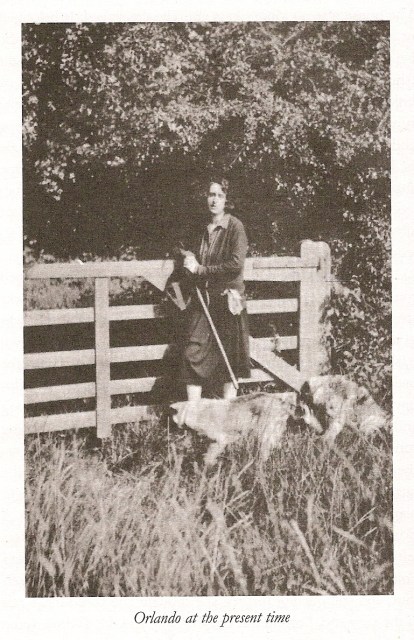
Virginia famously wrote Orlando as a pseudo-biography of Vita, and the dogs referenced in the book are based on Vita’s real-life canine companions. These include Pippin, as well as her chief elkhound Canute, and a Saluki called Zurcha that she acquired in Iraq and wasn’t super-impressed with:
“without exception the dullest dog I ever owned … nothing would induce her to come out for a walk – perhaps because I omitted to provide a gazelle. In the end I followed the historical tradition and gave her to a Persian Prince, who subsequently lost her somewhere in Moscow.”
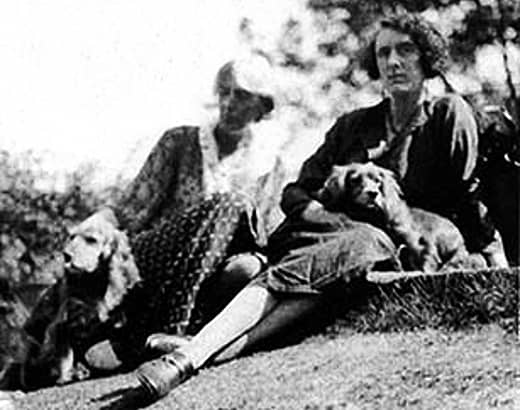
Vita and Virginia with dogs
Virginia’s foremost foray into canine literature though, was Flush: A Biography. On the surface, a parody biography of the dognapped pet of Elizabeth and Robert Barrett-Browning, told from his own perspective, it also incorporates much from Virginia’s own life, including allusions to her childhood abuse and explorations of the human-canine bond, and draws from the many years spent walking her own dogs round the streets of London.
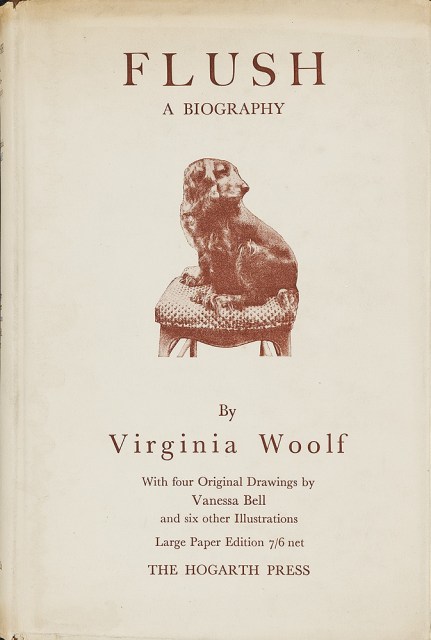
By the late 1920s, Virginia and Vita’s affair was on the rocks. Everyone processes breakups in their own way, and there’s a lot of good advice out there, but really is there any better method than comparing your failed relationship to the long and painful death of your imaginary dog?
“Potto is dead. For about a month (you have not been for a month and I date his decline from your last visit) I have watched him failing. First his coat lost lustre; then he refused biscuits; finally gravy. When I asked him what ailed him he sighed, but made no answer. The other day coming unexpectedly into the room, I found him wiping away a tear. He still maintained unbroken silence. Last night it was clear that the end was coming. I sat with him holding his paw in mine and felt the pulse grow feebler. At 7:45 he breathed deeply. I leant over him. I just caught and was able to distinguish the following words—“Tell Mrs. Nick that I love her….She has forgotten me. But I forgive her and…(here he could hardly speak) die…of…a…broken…heart!” He then expired….Oh my God—my Potto.”
Virginia and Vita remained on good terms after their romantic relationship ended, right up until Virginia’s suicide in 1941. Vita continued her writing, and become a celebrated gardener at her estate in Sissinghurst, where she created a small dog cemetery to commemorate several of her canine comrades, including Martha, Dan and her favourite Alsatian, Rollo. She drew together her love of dogs and travelling in her 1961 book Faces: Profiles of Dogs which combined photos of her favourite breeds with amateur history and her own anecdotes.
“Half the horrors of illness cease when one has a book or a dog or a cup of one’s own at hand.”
Mary Woolley and Jeanette Marks
Mary Woolley and Jeanette Marks were lifelong companions and educators who spent most of their lives fulfilling as many lesbian stereotypes as possible before the popularisation of plaid.
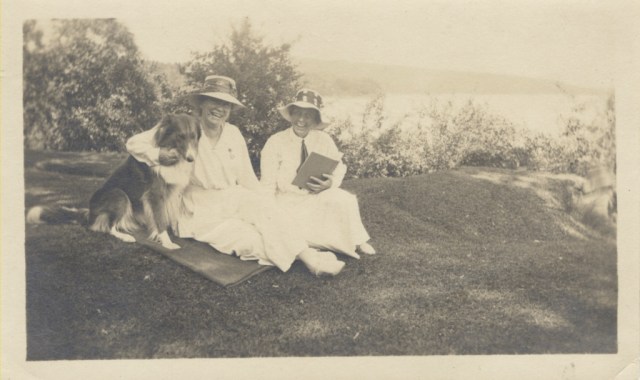
Mary and Jeanette with dog
Mary was born in Connecticut in 1863, and after great success as a student, began teaching at the all-female Wellesley College in 1895. That same year, the young Jeanette Marks began studying at Wellesley, beginning five years of simmering attraction between the student and professor, despite the 12-year age gap. In 1900, Mary got a job at another college and with the threat of separation, the pair’s slow burn burst into an incandescent reveal via a series of increasingly passionate letters.
“Jeannette – Does it seem possible that it is only a few short weeks since we have felt first we could say all that we feel, without restraint or constraint? Two such proud ladies, too, each one afraid that she felt more than the other and determined to keep her own self-respect!” – Mary Woolley, 1900, providing evidence that lesbians have struggled to work out if their gf really fancies them for 100+ years
Mary’s new position was as president at Mount Holyoke, another all-female college, where administrators had to rotate students’ rooming arrangements every couple of weeks to stop them getting too “attached” to one another.
I know a nice place for young girls to go, Mount Holyoke you know, Mount Holyoke you know,
Where life’s a gay whirl and things never are slow, Mount Holyoke, Mount Holyoke you know.
…
Here Freshmen fall madly in love twice a week, With a Senior you know, with a Senior you know
They load her with flowers but never dare speak At Holyoke, Mt. Holyoke you know.
– actual lyrics from Mount Holyoke song book 1901
Mary had a job on her hands to rehabilitate Holyoke from its past as the seminary from Emily Dickinson’s era, into a modern educational establishment. When Jeanette graduated, Mary was quick to use her powers of lesbian nepotism to install her as a teacher in Holyoke’s English department, and they began their life together, firstly in the college’s residential Brigham Hall, where Mary would climb three flights of stairs every evening to kiss Jeanette goodnight. In 1909, they moved in together to the newly-built President’s House, and soon filled it with Collies.

Mary Woolley
Woolley and Marks weren’t the only Collie-loving female educators in the state; the couple knew Katherine Lee Bates and Katherine from their time at Wellesley, who gifted Mary and Jeanette a Collie dubbed “Lord Wellesley” in recognition. He was soon joined by a pup called Ladybird Holyoke, and the couple usually had four or five Collies at any one time, including:
Old Mannie, Bird, Flag, Tyke, Turvey, Buddy, Chuckie Chuckles, Heron, Bummy, Blue Boy, Arrow and Tuttle
When Mary spent six months studying schools in China, she was welcomed back with a great fanfare to campus, with students lining the road singing specially-composed songs, and the Collies all decorated in bows. Mary also traveled to Geneva as the only American woman to attend a global disarmament conference, and wrote home to her dogs while she was there.
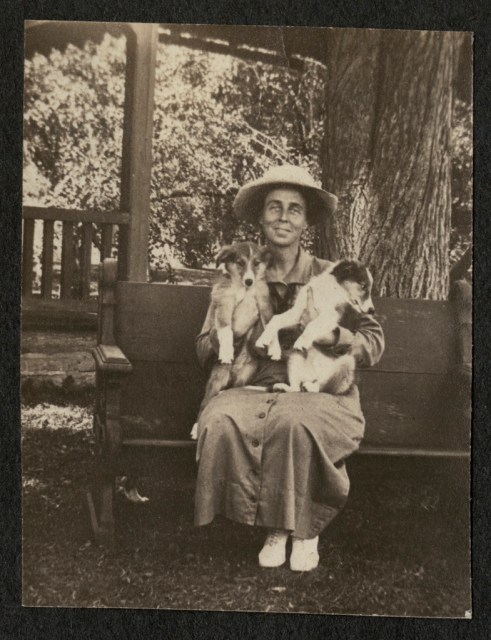
Jeanette Marks
While Mary’s career and reputation went from strength to strength, Jeanette struggled with indifference to her teaching role, stuttering success in her writing career, and the frequent feeling that her position at the college was purely because of her relationship with Mary. What’s more, while Jeanette had been a dog-lover her whole life, and was the driving force behind their ever-growing collection of Collies, and sometimes bred them, the dogs became known as Mary’s and become an integral part of her increasing public profile. Jeanette was said to be more than a little disgruntled that Mary had appropriated the dogs as her own.
“everyone who knows her knows her love of dogs and knows their devotion to her. For more than twenty-five years collies have been as truly members of the household as any human.” Mary Woolley, about Jeanette Marks
Despite these ups and downs, the couple remained together, and continued their work at Holyoke until Mary was prematurely ousted from her position as president in 1937, during a squabble about her successor. The couple retired to Jeanette’s family home, Fleyr-de-Lyr in Westport, New York, although both kept active with writing and public speaking. Mary’s health gradually began to fail, and she suffered a stroke in 1944. Still, Jeanette reminded her that they had “a pleasant and kind old home, happy doggies, good food and many faithful friends.” Jeanette cared for Mary until her death in 1947, and remained at Fleur-de-Lys, swimming daily with her beloved Collies, until she died in 1964, aged 88.
Ethel Smyth
Indomitable composer, author and general force of nature, Ethel Smyth was born in Sidcup, Kent in 1858. At the age of twelve, Ethel was introduced to classical music by a governess who had studied in Leipzig. Immediately Ethel was determined to become a composer and follow in her teacher’s footsteps to study at the Leipzig Conservatoire. Her father, a stern military man, objected to the notion, which only emboldened Ethel, who spent the next five years waging a varied campaign of arguments, silent treatment and general obstreperousness until she got her own way.
Travelling to Germany in 1877, Ethel fell under the wing of composer and music scholar Heinrich von Herzogenberg, and under the spell of his wife Lisl. For the next seven years, Ethel honed her musical skills while conducting an affair with Lisl who, at eleven years her senior, would be the first in a series of quasi-maternal objects of obsession. Things took a soapy turn in 1882, when Ethel travelled to Florence to meet Lisl’s sister Julia and her husband, the English-American philosopher Henry Brewster. Ethel developed a deep rapport with both husband and wife; Henry made advances that she rejected, but Ethel would go on to form a lifelong friendship with him. Julia, on the other hand, Ethel fell hard for, and thought nothing of sending lengthy letters to Lisl describing her newfound infatuation with her sister. Sadly, Lisl had not got to the compersion chapter of The Ethical Slut and her relationship with Ethel began to break down. Lisl broke all ties in 1885, sending Ethel into a state of creative and emotional turmoil she called “The Desert.”
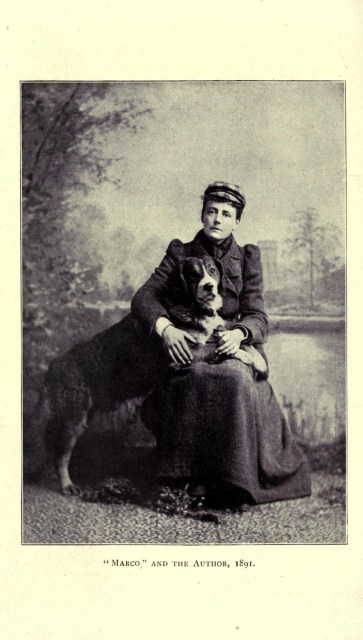
Ethel and Marco
Ethel found her way out of this bleak patch thanks to a gift from an old friend in Leipzig: “a huge sprawling yellow-and-white puppy of the long-haired kind generally seen dragging washerwomen’s carts. Half St. Bernard and the rest what you please, Marco was an entrancing animal…For twelve years that dog was the joy of my life, and latterly the terror of my friends.”
“A greater philosopher, a more perfect comrade for a busy woman, can have never existed” – Ethel on Marco
Marco stuck to Ethel’s side as she travelled around Europe, building her reputation as a composer of note. Marco also worked on his own reputation, interrupting a Brahms recital by knocking a table over (Brahms didn’t mind), and terrifying Tchaikovsky.
“Wherever I went Marco went, and wherever Marco went he made history.”
Ethel eventually consummated her relationship with Henry Brewster, which didn’t impress her hugely: “I remember arguing with him beside the Grandes Eaux as to whether any, any, any woman could ever have enjoyed such an experience.” Nevertheless, their relationship continued in the form of passionate letters, with infrequent meetings, while she pursued numerous entanglements with women. These included more keep-it-in-the-family love triangles with Mary Benson (an archbishop’s widow who shacked up with another archbishop’s widow, Lucy Tait) and her daughter Nellie, and with devoutly Catholic Pauline Trevelyan and her mother. In 1891, Ethel met Lady Mary Ponsonby, wife of Queen Victoria’s private secretary, and they enjoyed a lengthy relationship, no doubt helped by the fact that Mary didn’t mind Ethel’s constant flirting with other women.
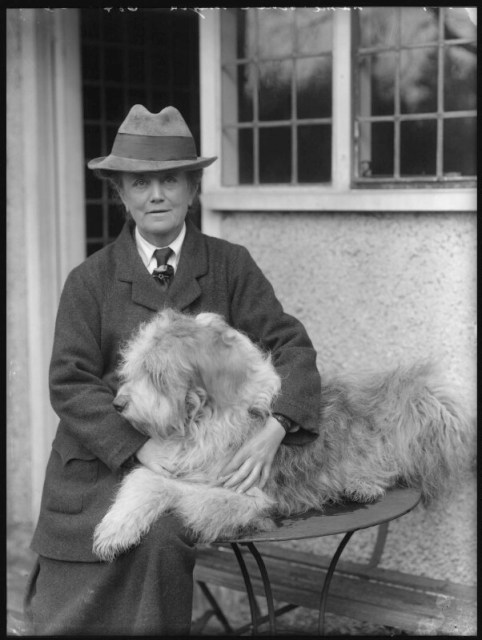
Ethel and one of the Pans
After many years of travels round Europe and back to England, In 1899, Marco’s health deteriorated, and he was put down. On a friend’s recommendation, Ethel got a sheepdog puppy, that she named Pan, the first in a dynasty of Pan I – VI – all of whom she would chronicle in her book “Inordinate Affection: A Story for Dog Lovers.” Throughout the romantic inconsistencies of her life, the sheepdogs provided robust companionship, especially her favourite of the bunch, Pan IV, who she guiltily confessed she loved more than all the others put together.
“Mad keen on life in its every manifestation, yearly growing more beautiful, more adorable, and a more incredibly perfect companion, for seven and a half years we walked down the calendar, step by step” – Ethel describing Pan IV the way you wish your girlfriend described you
Despite increasingly failing hearing, Ethel consolidated her career a highly successful composer, with well-reviewed performances around Europe, and for more than a century was the only woman to have an opera staged at the New York Metropolitan. In 1910, Ethel took a break from music to fully devote herself to the women’s suffrage movement in England, specifically the militant suffragettes of the WSPU and their leader Emmeline Pankhurst, on whom she developed a giant and unrequited crush. The pair occupied neighbouring cells during their stint in Holloway Prison, where Ethel famously conducted a rousing version of her suffragette anthem The March of the Women out of her window, using a toothbrush.

Ethel and Virginia
In 1922, Ethel was made a Dame of the British Empire for her services to composition, but by the 1930s, her hearing loss forced her to all-but abandon music. Undaunted, she turned to writing, prolifically, producing nine volumes of autobiography as well as her dog chronicles. She was spurred on in her endeavours by the last of her great crushes, Virginia Woolf. Woolf was not particularly flattered at first: “An old woman of seventy-one has fallen in love with me. It is at once hideous and horrid and melancholy-sad. It is like being caught by a crab.” However, a woman of seventy-one has very few fucks to give, and Ethel mounted a successful campaign of badgering via letters, using killer lines such as “I had not meant to tell you. But I want affection. You may take advantage of this.” Although Virginia never returned close to the same level of affection, the pair wrote voluminous letters and met regularly until Virginia’s suicide.
Ethel’s health began to fail in the 1940s, and by 1944 she was worn down with illness and the premature death of Pan VI. Suffering from the pneumonia she would shortly succumb to, she told her nurse: “I think I shall die soon, and I intend to die standing up.” Although she did not manage that physically, she certainly stood up until the end with her indefatigable spirit.

Ethel and one of the Pans
Gertrude Stein and Alice B Toklas
Ultimate literary top Gertrude Stein and the woman whose autobiography she stole for herself, Alice B Toklas, met in 1907 in Paris.

Gertrude Stein with dogs
Gertrude had relocated there in 1903, after a brief and bored stint as a medical student, to start an art salon with her brother with an inheritance. Alice was ostensibly taking a long-planned trip with a friend to Paris, and met Gertrude on the day she arrived. They fell in love immediately, but shockingly took almost three years to move in together. Thus began several decades at their salon, with Gertrude writing, while Alice cooked, and the pair hosted the artistic and literary luminaries of the day, including Picasso, Matisse and Hemingway.
Gertrude and Alice got their first dog, a Majorcan hound called Polybe, while holidaying in Spain. He was reddish-brown with black stripes on the back, enjoyed eating flowers and resisting all their attempts to train him. Although no pictures exist of Polybe, he crops up a lot in Stein’s earlier works.
By the mid-1920s Gertrude and Alice were looking to advance their U-Hauling to the next level and sought out a summer home in eastern France. While they were waiting for the paperwork for their new home to go through, they spotted a blue-eyed white poodle puppy at a local dog show in Paris. Alice said she had wanted a white poodle for many years, after reading about one in Henry James’s The Princess Casamassima, which is quite a feat considering the book doesn’t actually feature one. Alice christened the puppy Basket, because she “said he should carry a basket of flowers in his mouth. He never did.”
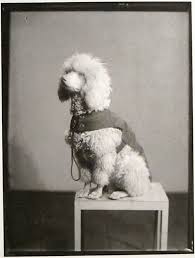
Basket by Man Ray
They moved to their new country home, and soon Basket grew into a bounding giant, and a star in his own right among their circle of friends. Dadaist photographer Man Ray took a series of portraits of Basket with and without Gertrude, Dutch artist Kristians Tonny painted Gertrude with Basket, and Picasso gifted Stein and Toklas Hommage a Basket as an offering after his own dog, an Airedale named Elf, had trampled over their flowers and got into a tiff with Basket.
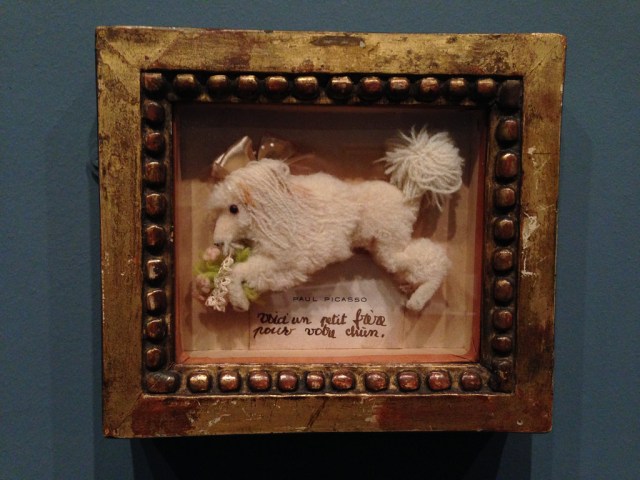
An hommage to Basket
Basket was soon followed by a Mexican chihuahua gifted to them by artist Francis Picabia, on account of their admiration of his own chihuahua. They named him Byron owing to his overly-fond admiration for his own sister. His arrival engendered great jealousy in Basket, who ran away for attention. Byron died of typhus, but Picabia gamely provided another chihuahua named Pepe, who although physically identical to Byron, was of a much gentler nature and loved by all.
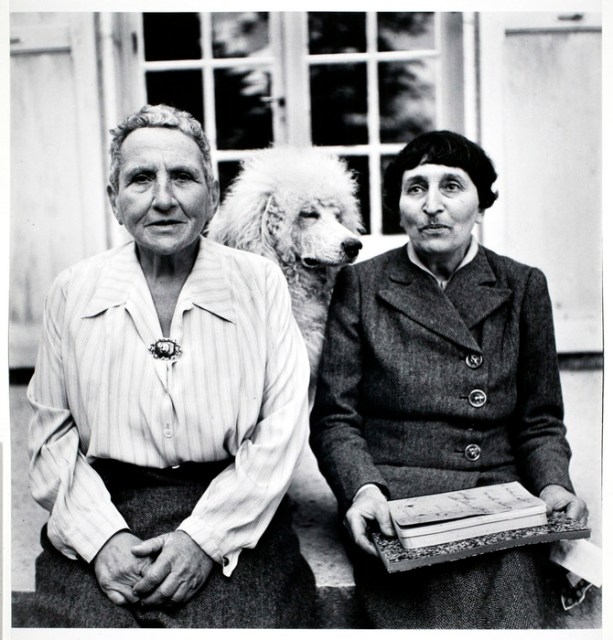
Gertrude and Alice with Basket II
Basket died in 1937, but the couple soon replaced him with another white standard poodle that they acquired in Bordeaux, who they imaginatively named Basket II. Unlike his predecessor, Basket II was fully pedigreed, and when war broke out and Stein and Toklas were living under German Occupation, this purebred status allowed Basket II extra rations, as apparently the Nazis obsession with master races was not limited to humans. Sadly, the winter cold got to Pepe, who became ill during the occupation, and died. Basket II continued on in great health, outliving Gertrude, who died in 1946. Like his predecessor, Basket II featured in several artworks, including a portrait by Marie Laurencin, which he is pictured next to in one of the most sublime images ever produced.
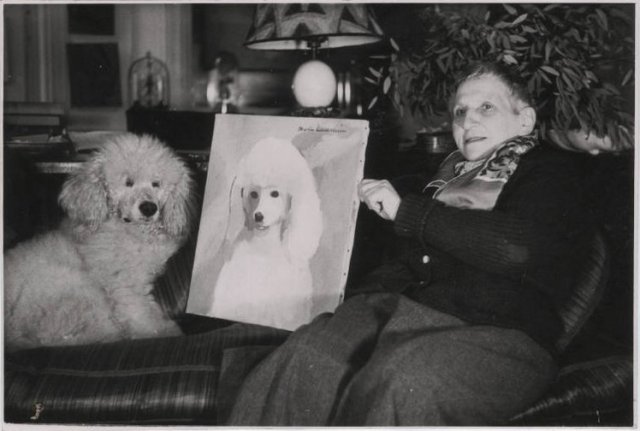
Basket looking at Basket
It is an astonishing literary omission that, having been propelled to fame by The Autobiography of Alice B Toklas, Stein never thought to dedicate autobiographies to Basket I or II, or any other of their dogs. However, she is the first on our list to have written a film about dogs! One of her few French-language pieces, Film: Deux Sœurs Qui Ne Sont Pas Sœurs, is a modernist take on Gertrude and Alice’s acquisition of the first Basket. It features versions of themselves in their own car, a picture of two poodles and one actual poodle, and sounds like quite a trip.
Other pieces of Stein’s dog-infused works include Doctor Faustus Light the Lights, and her short play Poem An Identity, which contains the oft-quoted “I am I because my little dog knows me even if the little dog is a big one.” Reading the piece with an anachronistic eye, one imagines it could be a poem created by a neural network trained on the fever dreams of visitors to a West Hollywood dog park (both human and canine).
“The person and the dog are there and the dog is there and the person is there and where oh where is their identity, is the identity there anywhere. I say two dogs but say a dog and a dog.”
After Gertrude died, Alice finally reclaimed her own life story and put out a memoir in the form of a cookbook, containing such classic recipes as Hashish Fudge. She continued to look after Basket II until his death in 1952.
Fill In Your Butch History With This Coloring Book
“Beautiful, handsome, and ever charming, these 1920s-1940s Butches await your celebration, your admiration, and, of course, your color schemes,” writes Sasha T. Goldberg for the Butch Lesbians of the 20s, 30s, and 40s Coloring Book by Avery Cassell and Jon Macy.
The coloring book features Bessie Coleman, Thelma Wood, Frieda Belinfante, Jackie Bross, Cherifa, Willa Cather, Gladys Bentley, Gertrude Stein, Gwen Farrar, Joe Carstairs, Louisa D’Andelot Carpenter, Moms Mabley, Olga Tsuberbiller, Ruth Ellis, Yoshiko Kawashima and other dapper butch figures, drawn by queer artists including Paige Braddock, Robyn Adams, Tara Madison Avery, Katie Gilmartin, Maia Kobabe, Ajuan Mance, and others, as well as biographies by Avery Cassell and a forward by Goldberg. Why learn about herstory when you can learn about herstory by way of babes?
Below: your very own printable coloring book preview and mini history lesson. Ten points to anyone who uploads colored-in pages in the comments.

Cherifa by Jon Macy
Cherifa, aka Amina Bakalia (1928 to the late 1990s), was the first woman grain seller in Tangier, Morocco; an out butch lesbian; and a notorious womanizer. Her twenty-year affair with American novelist Jane Bowles is captured in A Little Original Sin: The Life and Work of Jane Bowles by Millicent Dillon.
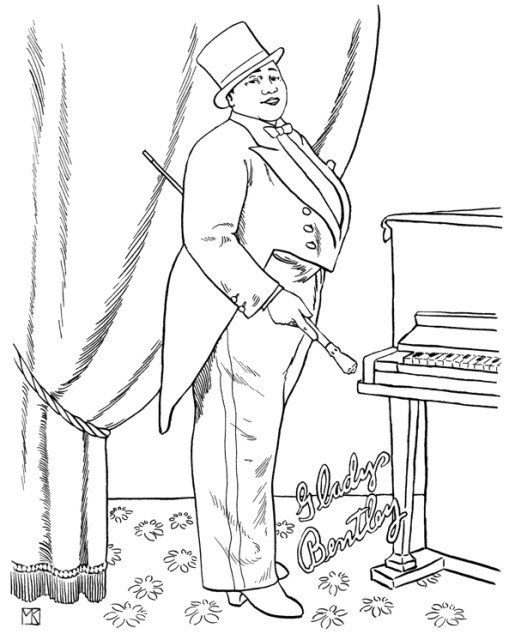
Gladys Bentley by Maia Kobabe
Gladys Bentley, aka Bobbie Bentley (1907–1960), was a renowned blues singer during the 1920s and 30s and a pianist and entertainer during the Harlem Renaissance. In 1931, she scandalously married her white girlfriend in a civil ceremony in New Jersey, which later led to an investigation by the U.S. House Committee on Un-American Activities and McCarthy-era pressure to (unconvincingly) renounce her lesbianism.
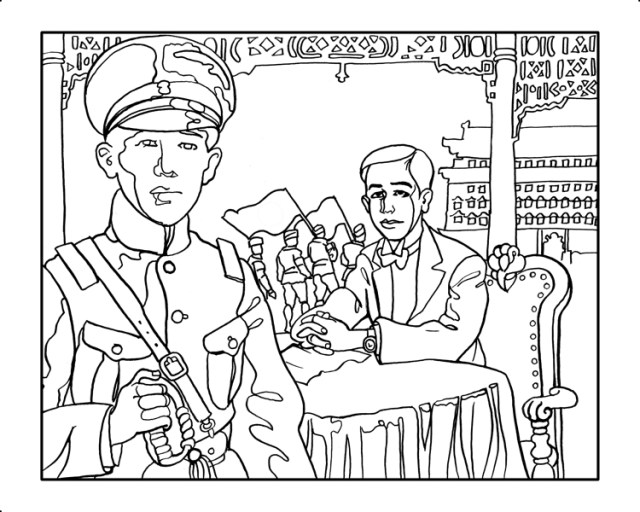
Yoshiko Kawashima by Jon Macy
Yoshiko Kawashima, aka the “Joan of Arc of the Manchus” (1907–1948), was a Chinese princess who cut her hair off and began to wear men’s clothing at age 18. She was a spy for the Japanese Kwantung Army, and after the war was captured and executed by the Republic of China. In life, she was bisexual. In the Chinese language, her name is synonymous with “female spy.”
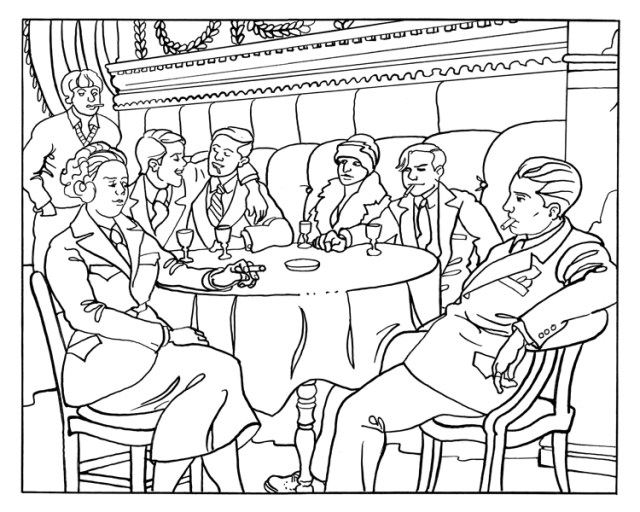
Cigars in Berlin by Jon Macy
These anonymous butches are smoking cigars at the women-only Damenclub Violetta in 1920s Berlin, what Cassell calls “the lesbian capital of the universe” until Nazis took over.
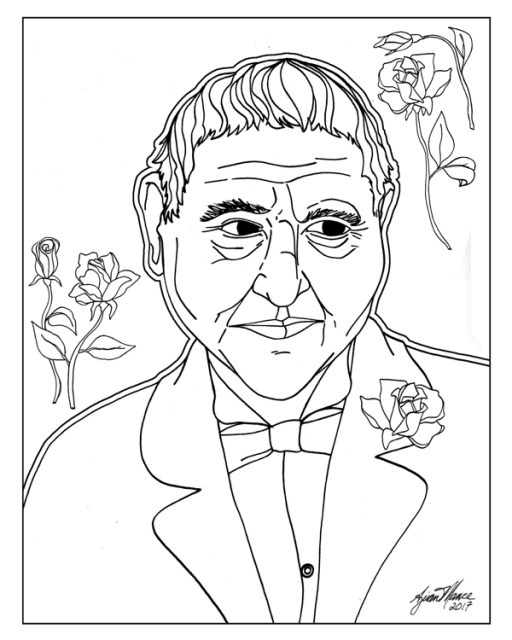
Gertrude Stein by Ajuan Mance
Gertrude Stein (1874–1946) was a novelist, poet, playwright, art collector and patron, and overall force in the Parisian avante-garde. She was married to Alice B. Toklas for 36 years, and together they ran a salon, escaped WWII, and wrote a ton of love letters.
16 Lesbian Power Couples From History Who Got Shit Done, Together
Lesbians are well-known for our unique ability to find a girlfriend and then turn that romantic relationship into an all-consuming life partnership — starting businesses, pursuing activism, revolutionizing social services, erecting schools, liberating marginalized groups. This is true today but has also been true since the beginning of time. Back in the day, many women were held back from activism and entrepreneurship by the demands of marriage and motherhood, making some women-loving-women uniquely able to pursue civilization-shifting ventures. (Although many managed to do both!) We’re gonna talk about some of those relationships here today.
For the purposes of this list, I defined “power couple” as a relationship through which both women were able to achieve greater professional, artistic or service-related success because of their relationship with each other. I leaned towards couples that actually made or did things together — whether that be starting a school, hosting a nightclub, creating social services for disadvantaged humans or making films. Also, as usual, the word “lesbian” is used as an adjective to describe a same-sex relationship, not the sexual orientation of the women in the relationship.
Sources include Elisa Rolle’s Days of Love: Celebrating LGBT History One Story at a Time, Lilian Faderman’s To Believe in Women: What Lesbians Have Done For America – A History and Christina Anne Wooner’s incredible thesis I stayed up late reading last night, “The Famous Lady Lovers: African American Women and Same-Sex Desire from Reconstruction to World War II.” Most other sources are linked within the post. I found a lot of contradictory information throughout my research so I imagine many of you will have some of your own!
For this installment, I’m focusing on couples who began their courtship prior to 1940. Future installments will obviously be more racially diverse as we move into eras where non-white people had more access to “power” and also more recorded histories.
16 Lesbian Power Couples, 1830s – 1940s
Rebecca Perot and Minister Rebecca Cox Jackson (1830s-1871)
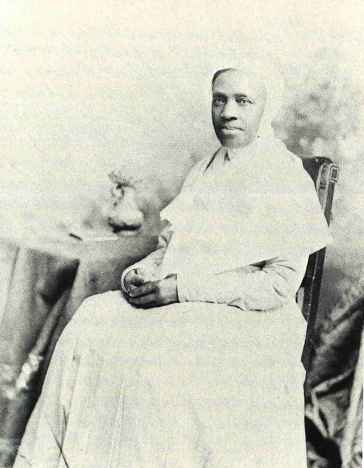
Rebecca Perot, aka Rebecca Jackson (There are no known pictures of Rebecca Cox Jackson) via shaker museum sketchbook
Rebecca Cox Jackson was raised in an African Methodist Episcopal family but, following a spiritual vision that put the voice of the divine within her, she broke off from the patriarchal church to start her own thing. Her success as a preacher led to her divorce, which led to her traveling around Pennsylvania and New England sharing her gifts, eventually falling for the community she found within a woman-led group of Shakers. She became a Shaker minister and met Rebecca Perot, with whom she joined a sect of the Watervliet Shakers. Eventually the two women — whose “mystical visions” had feminist and homoerotic undertones and often featured the other in divine contexts — decided they’d had it with white people and started their own family of black Shakers in Philadelphia, combining black female praying band traditions with Shaker theology. When Jackson died in 1871, Perot re-named herself “Mother Rebecca Jackson Jr” and took over the Philadelphia family.
Sallie Holley and Caroline Putnam (1848 – 1893)
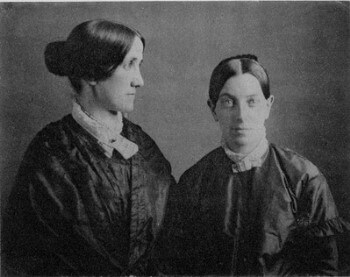
photo via civil war women
Sallie and Caroline met at good ol’ Oberlin College, and the noted “anti-slavery team” became agents of the American Anti-Slavery Society immediately after graduation. They traveled on the abolitionist lecture circuit, often along with the legendary Sojourner Truth. After the Civil War, Sallie stayed up North giving talks, raising money to educate freed slaves in the South, and Putnam went to Virginia to teach freed slaves, eventually starting The Holley School, which became America’s first settlement house. Sallie then joined Caroline in Lottsburg, where they integrated themselves with the community, operated their school year-round and unlike some future suffragettes, were dedicated to enabling, preserving and protecting the right of Black men to vote even when white women could not yet do so. Sallie died in 1893 and Caroline in 1917, at which point the school was deeded to an all-Black board of trustees and continued operating for decades.
Harriet E. Giles and Sophia B. Packard (1855-1891)
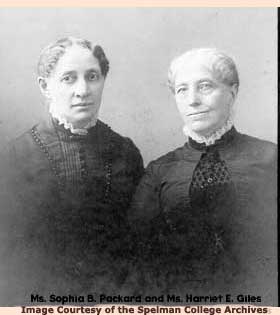
image via keeping & creating american communities
Giles met Packard in in the mid-1850s when Giles was a student at the New Salem Academy in New Salem, Massachusetts, and Packard was the preceptor. They hit it off right away, and shortly thereafter shuttled off to Atlanta to start a school for Black women who had been newly released from slavery. Packard was the first president of the school, then known as the Atlanta Baptist Female Seminary and now known as Spelman College, when it opened its doors in 1888. Giles took over after Packard’s death in 1891. The two women are now buried next to each other in Silver Lake Cemetery.
Ellen Gates Starr & Jane Addams (1877-1892)
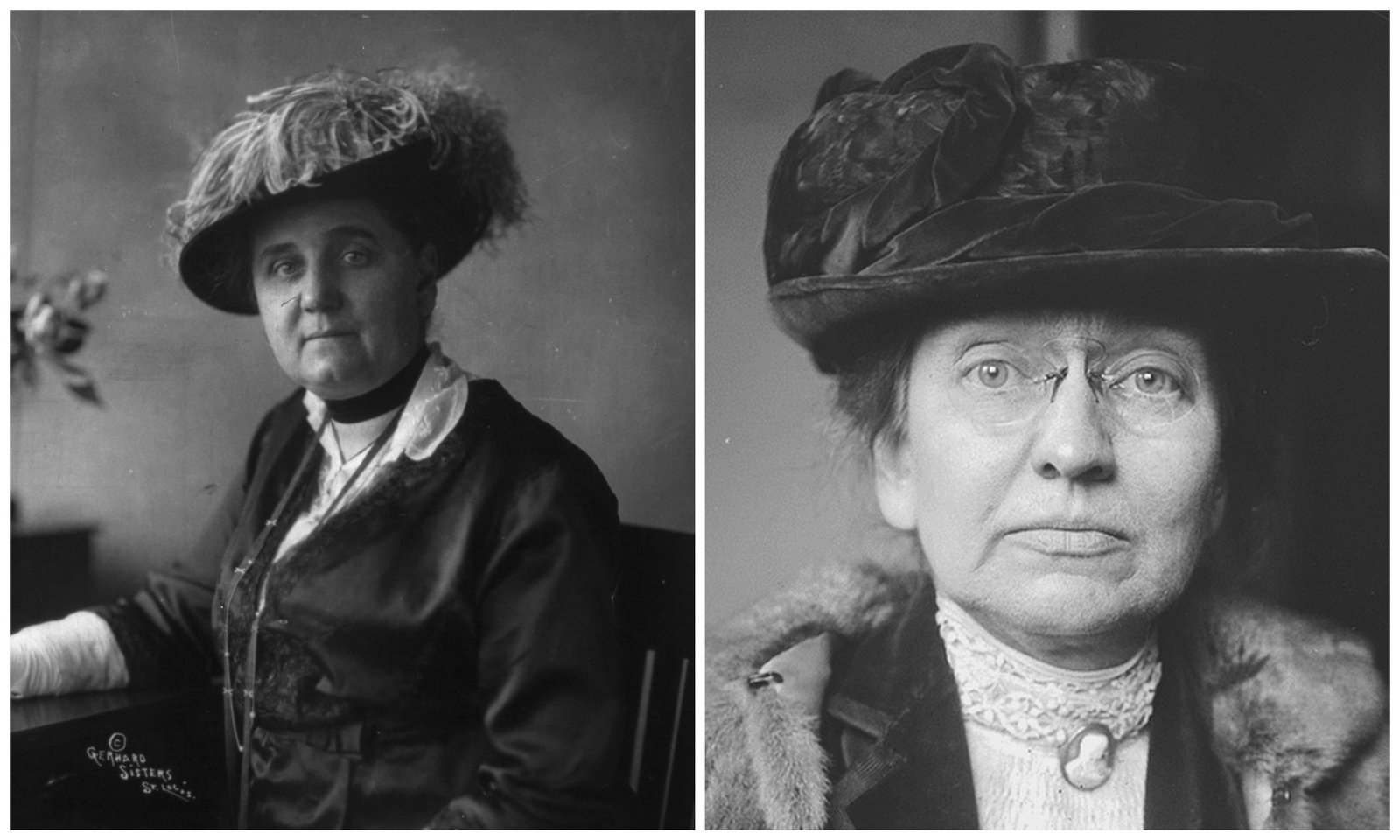
Ellen Gates Starr met Jane Addams at the Rockford Female Seminary in 1877, and it was through their relationship that Addams got the confidence to embark on the GROUNDBREAKING AND INFLUENTIAL Hull House Project in Chicago. The Hull House was part of a movement to provide social and educational opportunities for working class women, mostly recent immigrants; offering classes in literature and history, hosting public concerts, providing child care and putting on free lectures. The two women taught classes, served as on-call midwives, sheltered victims of domestic violence, and advocated for legislative reforms that are now seen as the first models for “social welfare.” Ellen was far more religious than Jane, which may have played a role in their eventual breakup. Jane subsequently moved right along, in classic lesbian fashion, to Mary Rozet Smith, the daughter of a wealthy Chicago industrialist, who was very helpful to Addams’ various missions through other means.
Edith Anna Somerville & Violet Florence Martin (1887-1915)

Edith, an Irish novelist and her cousin/girlfriend (listen it was a different time), Violet, co-wrote fourteen stories and novels under the name “Martin Ross.” Their most popular titles were The Real Charlotte and The Experiences of Irish R.M.. After Violet’s death, Edith was inconsolable, and decided to keep writing as Martin Ross, convinced the two were communicating through spiritualist séances, which I personally feel is totally legit.
Ethel Mars & Maud Hunt Squire (1894-1954)
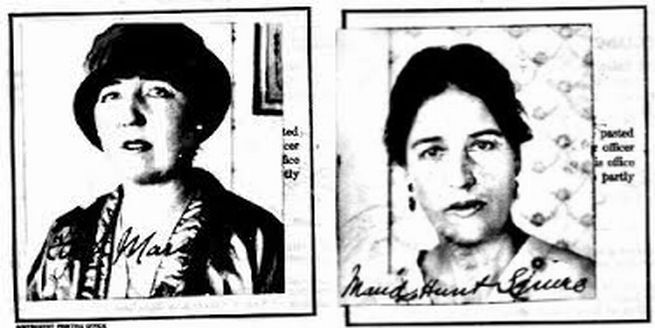
image via pinterest
These two American artists met at the Cincinnati Art Academy in the 1890s and stayed together for 60 years, living for patches in France and in Provincetown, Massachusetts. Maud was known for her book illustrations and color etchings, Ethel for her painting, color woodblock prints and drawings. They collaborated on projects like illustrating the legendary Child’s Garden of Verses. The couple were regulars at Gertrude Stein’s salon in France (and the subject of her word portrait Miss Furr and Miss Skeene). Also, The New York Times says they “loved to behave outrageously.”
Mabel Reed & Mary Ellicott Arnold (1894-1963)
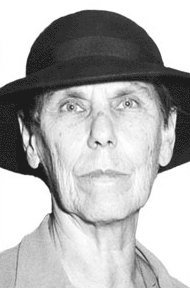
Mary Ellicott Arnold, via wikipedia
Mabel and Mary were together for around 69 years, having met as children in New Jersey, and went on to be prominent urban organizers, philanthropists and social activists. After five years of middling success farming a 50-acre plot, they put in time at the City and Suburban Homes Company, which provided housing solutions for the working poor. They were then positioned as “field matrons” at the Hoopa Valley Indian Reservation, where they defied pressure to enforce white cultural values upon the Natives who lived there, and wrote the book In the Land of the Grasshopper Song. Later organizing projects included cooperative cafeterias and apartments in New York, credit unions for lobster fisherman and cooperative housing projects for coal miners, as well as many other housing projects throughout the Northeast. They became widely regarded social activists and organizers, known for their drive to include women in their husband’s housing decisions and unconcerned by critics of their unconventional behavior — wearing divided skirts, riding horses through the backwoods, living in non-white areas, and thwarting conventional Victorian female ideals.
Fannie Johnston & Mattie Edwards Hewitt (1901-1917)
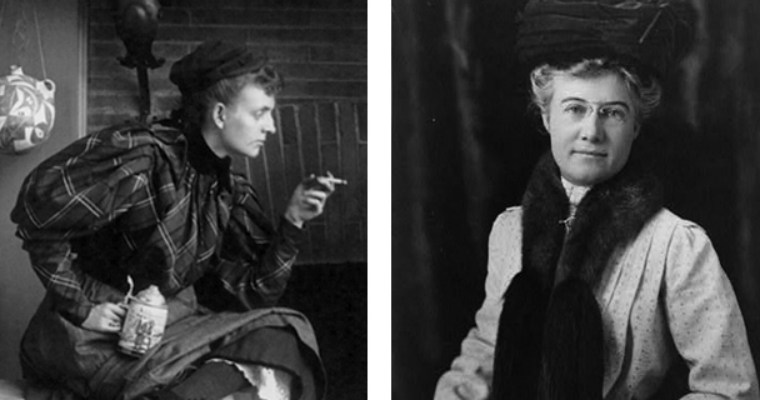
These two photographers met at the 1901 Pan American Exposition in Buffalo. Johnston was a pioneer in her field as one of the most successful female photographers in America, snagging cool gigs like shooting Edith Wharton’s Paris-adjacent villa, Booker T Washington’s face and Alice Roosevelt’s wedding. Hewitt was then working as an assistant to her husband, also a photographer, who she officially divorced in 1909. Thus, after eight years of an intense epistolary long-distance love affair with Fannie, Mattie U-Hauled with Fannie in New York, eventually opening an architectural photography studio together. Like so many great power lesbian couples, Mattie’s admiration of Fannie’s work was instrumental in what drew them together. They were commissioned to photograph buildings like the Cathedral of St. John the Divine and the Hotel Manhattan. Then in 1917 they had a huge blowout fight and broke up forever.
Gertrude Stein & Alice B. Toklas (1907-1946)

One of the most revered lesbian couples of all time, Gertrude Stein was an American novelist, playwright and poet with an unconventional style and a Modernist art collector. She met Alice B. Toklas, who would serve as her “confidante, lover, cook, secretary, muse, editor, critic and general organizer,” the day Toklas arrived in Paris. Stein fell hard and fast for Toklas, and by 1910 they were hosting a salon in their home on 27 rue de Fleurus that is now known as one of the most influential gathering spots in the history of arts, literature and queerdom. Guests included Pablo Picasso, Ernest Hemmingway, F. Scott Fitzgerald, James Joyce, Thornton Wilder, Sherwood Anderson, Henri Matisse, Ethel Mars, Maud Hunt-Squire, Eleonara Sears, Eva Le Galienne and Francis Cyril Rose. Toklas hosted the wives and the girlfriends and Stein handled the men. The duo hit the big time with the mass market publication of The Autobiography of Alice B. Toklas in 1933, which led to an extended U.S. lecture tour. Toklas and Stein were together until Stein’s death in 1946.
Frances Witherspoon & Tracy D. Mygatt (1908-1973)

via Days of Lore
Frances and Tracy both graduated from Bryn Mawr in 1908, and then committed themselves entirely to the causes that mattered to them: world peace, pacifism, women’s rights and civil rights. But pacifism was always their number one passion. During World War I, they advocated for conscientious objectors: Tracy helped organize the Anti-Enlistment League and Frances founded America’s first-ever organization to support the rights of objectors as well as those persecuted for free speech, the Bureau of Legal Advice. The BLA is considered the forerunner of the American Civil Liberties Union, which was founded shortly thereafter, and which worked in tandem with the BLA towards common causes. They joined the Socialist Party in New York upon moving there in 1913, and helped organize shelters and food distribution programs in churches for the homeless. They were inseparable for 65 years, even dying within weeks of each other, which everybody knows is the ultimate lesbian love act.
Ethel Collins Dunham & Martha May Eliot (1910-1969)

Martha was a headstrong and stubborn young woman from the jump, refusing to marry and insisting on a life of travel and learning. She met Ethel, who’d felt uninspired by the socialite lifestyle she’d been living, at Bryn Mawr, and the two decided to attend medical school together, become doctors together, and live together forever and ever. AND THEY DID. They got their medical degrees from Johns Hopkins, where they were active in the local suffrage movement, but were then separated by subsequent work placements. Eventually they were reunited at the brand-new department of Pediatrics at the Yale hospital in New Haven. Martha undertook a study of rickets amongst low-income children, which launched her career in community pediatrics and then got her a gig as director of the Child Hygiene Department of the Children’s Bureau, around the same time that Ethel became one of the first female professors at Yale’s School of Medicine. Their ambitions, extensive research accomplishments and subsequent appointments — including President Truman naming Martha chief of the Children’s Bureau and Ethel becoming the first female member of the American Pediatric Society — often meant spending a lot of time apart, but as Faderman wrote in To Believe in Women, “they seem to have believed that their relationship gave them sustenance for the challenges and that their work and their life together were inextricably connected.”
Ethel Williams & Ethel Waters (1910s-1920s)
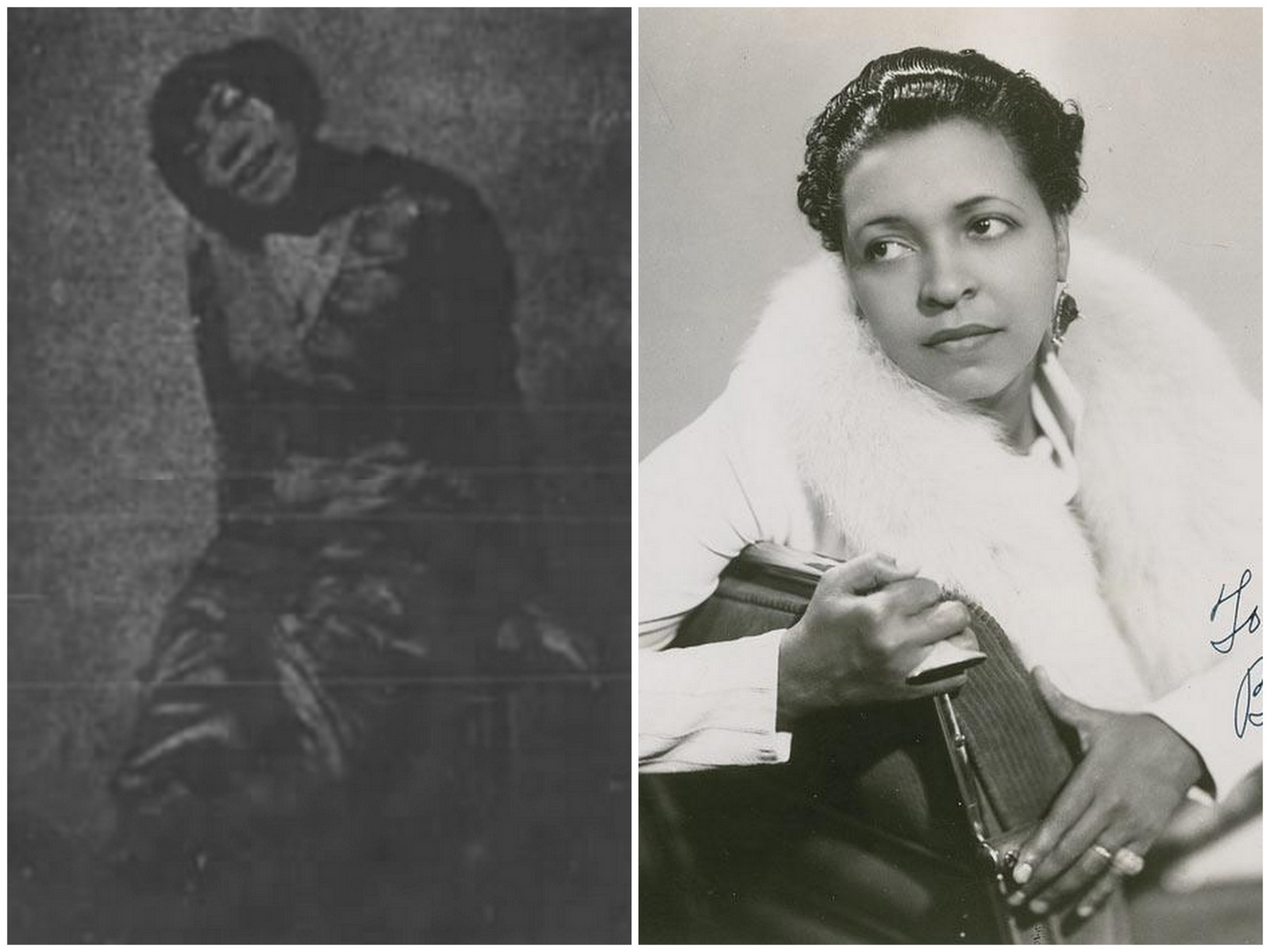
“The Two Ethels” met at the Alhambra Theater in Harlem — Ethel Waters was a popular blues singer and Ethel Williams was a dancer. They fell in love and summarily merged: Waters got Williams a job working at the cabaret where she worked, they lived together in Harlem and Waters took Williams with her on her first nationwide tour, where Williams would dance to warm up the crowd before Waters’ performances. In the touring revue Oh! Joy! they even did a little bit about being “partners” that winked at queer audience members while refusing mainstream identification. Waters’ managers at Black Swan Records manufactured gossip about Waters, once pushing a piece about how her recording contract stipulated that she couldn’t get married to explain her not having a male partner. Eventually, Ethel Williams left Waters and her job to marry a dancer named Clarence Dotson.
Florence Yoch and Lucile Council (1921-1964)

Considered “two of the finest garden designers and landscape architects in California,” Lucile started out as Florence’s “apprentice” at her firm and then became her “partner,” as you do. They designed estates, parks, movie sets and botanical gardens. Notable works include The Getty House gardens, the film sets for the exterior of “Tara” in Gone With the Wind and the estate of Howard Huntington. Their collected works are documented in the book Landscaping the American dream: the gardens and film sets of Florence Yoch, 1890-1972.
Dorothy Arzner and Marion Morgan (1927-1971)

via Lesbian News
Arzner was the only successful female film director of Hollywood’s golden age, and she met her beloved Marion on the set of Fashions for Women. Marion Morgan was a vaudeville dancer and choreographer who led her own performance troupe. They began working together on films and in 1930 and commissioned architect W.C. Tanner to build them a Hollywood Hills estate — Florence Yoch designed the gardens. They lived there for 40 years, until Morgan’s death in 1971.
Mabel Hampton and Lilian Foster, 1932-1978

Mabel Hampton, born in 1902, had a tumultuous childhood that took her from North Carolina to New York City to New Jersey and eventually to a job dancing in Coney Island just as the Harlem Renaissance was in full swing. She performed with stars like Moms Mabley and Gladys Bently and lived openly as a lesbian, eventually giving up dancing and becoming a domestic worker — for the family of the now-famous Joan Nestle. She met Lillian Foster in 1932, and they were inseparable until Lilian’s death, living together on 169th street in the Bronx and calling each other husband and wife. They were active in the Gay Rights movement, ran their own laundering business, and worked together to collect and organize a wealth of documents, newspaper clippings, photographs and books, including programs from the opera performances she and Foster loved attending, that would help form the Lesbian Herstory Archives, of which Joan Nestle named Mabel a founding member. Mabel’s oral history was preserved by Joan in the archives.
Ruth Ellis and Ceceline “Babe” Franklin, 1936 – 1971
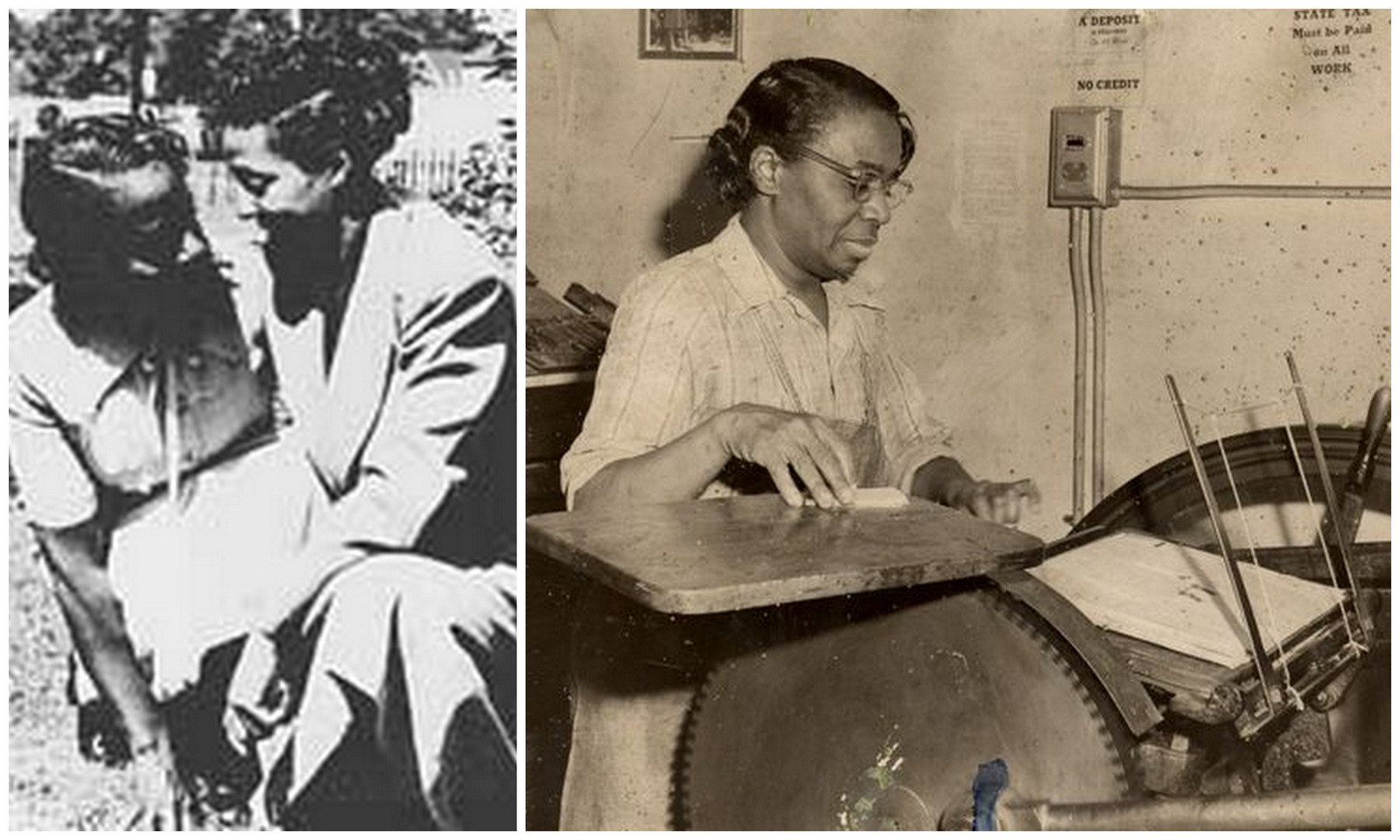
Ruth C. Ellis met Ceciline “Babe” Franklin in 1936, and then they moved to Detroit and launched Ellis and Franklin Printing, which made Ellis the first woman in the city to own her own printing business. Franklin worked as a chef. They bought a house in 1946 which became known as the “Gay Spot,” a gathering place for the local black gay and lesbian community. It was a welcome refuge for black folks who weren’t given access to the white bar scene. “Gay people didn’t have anyplace else to go,” Ellis said in Family: A Portrait of Gay and Lesbian America. “Everybody would bring a bottle. We used to dance a lot. We had a piano in the basement and we’d sing and play. We’d dance and drink and play cards.” They gave lodging to gay black men newly arrived from the south, and helped young folks through college. Since 1999, The Ruth Ellis Center in Detroit has been a place of refuge for homeless LGBTQ youth, so her incredible legacy lives on.
If you know of a lesbian couple who got together before 1940 and did cool shit, tell me about it in the comments!!!
Lesbians Face Discrimination in Dollywood, a Vermont Inn and a SF Gertrude Stein Exhibit
Earlier, we told you about the unexpected pleasure of finding allies in surprising places, like the Republican party or the political machine of the state of Utah. Unfortunately, today’s story is like the photo negative of that situation: this week, several lesbian couples and/or families have found themselves subjected to homophobia and discrimination in some of the last places you’d guess.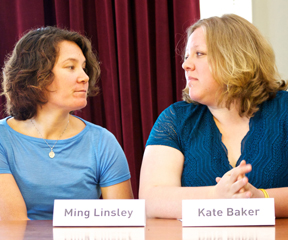
First, there’s Kate Baker and Ming Linsley, who were thrown off in the process of planning their (legally valid) Vermont wedding when the inn that they wanted to host it at refused to “host gay receptions at our facility.”
The current lawsuit alleges that in October Ms. Linsley’s mother, Channie Peters, spoke with the events coordinator at [the Wilflower Inn], which has 24 rooms and is on 570 acres in the Northeast Kingdom of Vermont, according to its Web site. Ms. Peters said the coordinator referred to a bride and a groom while discussing the bridal suite; Ms. Peters said she corrected the woman and they continued their conversation. Shortly after the conversation, Ms. Peters received an e-mail with the subject line “bad news,” according to the lawsuit, and was told the innkeepers did not allow same-sex wedding receptions at the site. “After our conversation,” the e-mail reads, according to the lawsuit, “I checked with my innkeepers and unfortunately due to their personal feelings, they do not host gay receptions at our facility.”
Vermont has had civil unions for gay couples since 2000, and legal same-sex marriage since 2009. While it does have a Republican population, it also boasts anti-discrimination laws around sexual orientation as well as gender identity and expression to cover discrimination in public places, schools, colleges, shops, and in employment. It even allows for joint adoption and second-parent adoption by same-sex couples, putting it within the upper echelon of Most Gay-Friendly States. So it’s understandable that Linsley and Baker would be shocked by this development. They’ve managed to book their wedding elsewhere in Vermont, and are now pursuing a lawsuit against the Wildflower Inn, the owners of which have refused to comment.
Another place you’d never expect to encounter homophobia is Dollywood, the theme park utopia of one of the entertainment industry’s most gay-friendly icons. Gay rights is one of the only political issues Parton speaks on, but she’s very vocal about it, and has vociferously supported marriage equality. She also made a surprise appearance at this year’s GLAAD Awards in Los Angeles.
So when Olivier Odom, Jennifer Tipton and their children went to visit Dollywood for the day, they were shocked that the entrance guard asked Odom to change her shirt, which declared “Marriage Is So Gay.”
Odom spoke with the Campaign for Southern Equality, who advised her to write a letter of complaint to Dollywood: “To ensure that your customers are not treated this way in the future, I would like to see Dollywood: implement policies that are inclusive of lesbian, gay, bisexual and transgender (LGBT) people; conduct staff sensitivity training; and issue a public statement indicating that the park is inclusive of all families.” Dollywood officials have said that while they have not yet reviewed the case of the entrance guard, they plan to contact the couple about their complaint.
Lastly and perhaps most ironically, there’s this gem: the lesbian couple who was reprimanded for holding hands in a Gertrude Stein exhibit. Gertrude Stein was one of the earliest lesbian icons in America, and wrote one of the earliest (although hard to find) coming out stories in the form of a tract called Q.E.D. written in 1903 and published in 1950 as Things as They Are, as well as the essay “Miss Furr and Miss Skeene” and contains what may be the first published use of the word “gay” to refer to homosexual orientation. She died in 1946, almost 30 years before Stonewall. So, for context: it was in an exhibit about this woman’s life at the Contemporary Jewish Museum that a lesbian couple were forbidden to HOLD HANDS. Luckily, the response was fairly satisfying:
This, of course, incited a fury. The couple began arguing with the guard. Soon a crowd formed. The guard tried to get rid of them due to the attention and noise he was now attracting. The women went further, saying, “No we are not leaving and we want to talk to somebody in authority right now.”
The museum claims no responsibility for the incident, explaining that the guards aren’t directly employed by the museum and that the one in question has been “reprimanded.” One can only imagine what Gertrude Stein would have had to say.
In conclusion, we are reminded that no matter how many steps we’ve taken forward, we still sometimes take a few steps back. But also that our community knows how to take care of itself – all of these troubling reports of discrimination end in the victims standing up for themselves and holding the parties responsible accountable. And while that’s not the same kind of heartwarming as as stories about people driven by compassion and goodwill to experience a spontaneous change of heart around gay issues, like Republican Jeff Angelo, it’s still what progress looks like.
Pure Poetry #32: Gertrude Stein & Mina Loy
Pure Poetry Week(s):
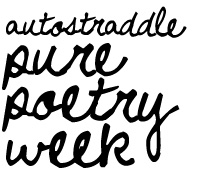
#1 – 2/23/2011 – Intro & Def Poetry Jam, by Riese
#2 – 2/23/2011 – Eileen Myles, by Carmen
#3 – 2/23/2011 – Anis Mojgani, by Crystal
#4 – 2/24/2011 – Andrea Gibson, by Carmen & Katrina/KC Danger
#5 – 2/25/2011 – Leonard Cohen, by Crystal
#6 – 2/25/2011 – Staceyann Chin, by Carmen
#7 – 2/25/2011 – e.e. cummings, by Intern Emily
#8 – 2/27/2011 – Louise Glück, by Lindsay
#9 – 2/28/2011 – Shel Silverstein, by Intern Lily & Guest
#10 – 2/28/2011 – Michelle Tea, by Laneia
#11 – 2/28/2011 – Saul Williams, by Katrina Chicklett Danger
#12 – 3/2/2011 – Maya Angelou, by Laneia
#13 – 3/4/2011 – Jack Spicer, by Riese
#14 – 3/5/2011 – Diane DiPrima, by Sady Doyle
#15 – 3/6/2011 – Pablo Neruda, by Intern Laura
#16 – 3/7/2011 – Vanessa Hidary, by Lindsay
#17 – 3/7/2011 – Adrienne Rich, by Taylor
#18 – 3/8/2011 – Raymond Carver, by Riese
#19 – 3/9/2011 – Rock WILK, by Gabrielle
#20 – 3/9/2011 – Veronica Franco, by Queerie Bradshaw
#21 – 3/10/2011 – Poems I Like, by Tao Lin
#22 – 3/12/2011 – William Carlos Williams & Robert Creeley, by Becky
#23 – 3/13/2011 – NSFW Sunday is Pure Poetry Edition, by Riese
#24 – 3/14/2011 – Charles Bukowski, by Intern Emily
#25 – 3/16/2011 – Rainer Maria Rilke, by Riese
#26 – 3/17/2011 – Lee Harwood by Mari
#27 – 3/18/2011 – Jeffrey McDaniel by Julieanne
#28 – 3/20/2011 – Dorothy Porter by Julia
#29 – 3/21/2011 – Sylvia Plath, by Riese
#30 – 3/24/2011 – Poems About Being a Homogay, by Riese
#31 – 3/28/2011 – Mary Oliver by Morgan
#32 – 3/29/2011 – Gertrude Stein + Mina Loy by Intern Emily
![]()
According to Mary E. Galvin, who wrote a book about Modernist queer writers which I used for my essay about Gertrude Stein and Mina Loy, who was not queer, Gertrude Stein is the most famous lesbian ever aside from Sappho (she wrote this before Ellen & Portia took over the world).
But Gertrude, who I affectionately refer to in my head as “Gerty Steinberg” (why??), was more than just a lesbian, obviously. She was a lesbian writer. She wrote lesbian fiction and lesbian plays and also lesbian poetry which is relevant to us because it’s pure poetry week and we’re gay, or something. Wikipedia says that Gerty was a Republican and in 1934 thought Hitler should be awarded the Nobel Peace Prize, but, like, I dunno, it’s Wikipedia and I haven’t read that anywhere else.
To be honest, the essay I wrote was not about Gerty’s life, so I don’t really know much about it. I hear she was a lesbian, and can’t really talk about anything else. But I do want to talk about her poetry.
Gerty only published one book of poetry in her lifetime, called Tender Buttons. It’s a fascinatingly weird thing, divided into three parts called Objects, Food, and Rooms. Gerty experimented with “verbal” cubism and prose poetry, and the result is a bunch of poems that look like absolute nonsense words relating to objects, food, and rooms, repeating themselves leaving you very confused.
For example, A Box:
Out of kindness comes redness and out of rudeness comes rapid same question, out of an eye comes research, out of selection comes painful cattle. So then the order is that a white way of being round is something suggesting a pin and is it disappointing, it is not, it is so rudimentary to be analysed and see a fine substance strangely, it is so earnest to have a green point not to red but to point again.
But a lot of Tender Buttons is about domestic space, and when you consider Gerty’s domestic space, it’s with another woman, so she’s writing from a female perspective about a home with no husband. Pretty cool for her time, huh?
Gertrude Stein also wrote a lot of things laced with sexual imagery, specifically lesbian sexual imagery. Take this line from Objects:
Aider, why aider why whow, whow stop touch, aider whow, aider stop the muncher, muncher munchers.
(When I was doing research about this, someone suggested that ‘Ada’ was Alice’s nickname (Gerty’s partner), and ‘Aider’ is a play on ‘Ada’, as in, aid her, like, help her orgasm.)
I wish that I could find an online version of A Book Concluding With As A Wife Has A Cow: A Love Story because also according to someone whom I read while doing research, ‘cow’ really means ‘orgasm’. Fun times.
Anyways, the point is that you should read Tender Buttons. Also, “tender buttons”? FEMALE EROGENOUS ZONES.
Now, moving on to Mina Loy. You might be wondering a) who is Mina Loy and b) why did I decide to stick her in a post with Gerty. Well, Mina Loy was also a Modernist poet (like Gertrude, though she was born later and lived longer), and she and Gerty were friends. Cool right?
In her time, Mina Loy was well known in North America and Europe, and now she is known nowhere. But you guys, Mina Loy was an awesome feminist single mother criticizer of the Patriarchy! She was popular with a lot of people, including one Ezra Pound who thought her work was so intelligent he invented the term ‘logopoeia’ to describe it.
Mina Loy claimed that she was “not a poet” despite writing over 300 poems. Unfortunately, most of them are not online. She also wrote a poem about Gertrude Stein, added in after her essay about Gerty:
Curie
of the laboratory
of vocabulary
she crushed
the tonnage
of consciousness
congealed to phrases
to extract
a radium of the word
She also wrote a poem about giving birth, which was a big Thing back in 1923. From Parturition:
Rises from the subconscious
Impression of a cat
With blind kittens
Among her legs
Same undulating life-stir
I am that cat
Rises from the subconscious
Impression of small animal carcass
Covered with blue bottles
— Epicurean —
And through the insects
Waves that same undulation of living
Death
Life
I am knowing
All about
Unfolding
The next morning
Each woman-of-the-people
Tiptoeing the red pile of the carpet
Doing hushed service
Each woman-of-the-people
Wearing a halo
A ludicrous little halo
Of which she is sublimely unaware
I once heard in a church
— Man and woman God made them —
Thank God.
Read all of Lunar Baedecker here, and if you have the chance, read some books with Mina Loy’s poetry in them! It’s kind of tricky since most of her stuff has been out of print since forever. The Lost Lunar Baedecker is a good place to start since it’s a compilation of a lot of her work.
Mina Loy was a feisty woman and I feel very affectionate towards her. I feel like if she were alive today she would be a super woman who kicks Maggie Gallagher in the face. Also, poetry!
